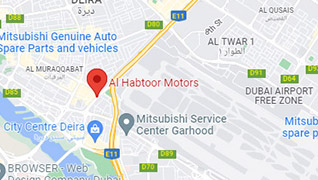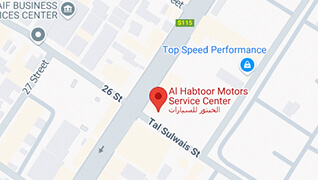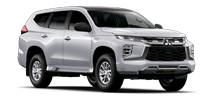
SERVICE
Tips on Driving Your Mitsubishi
Driving 4WD vehicles in sand
This is the time to use the 'special transfer shift lever' provided in your 4WD vehicle. Set the lever to '4H' or '4L' ('4H' or '4HLC' for super select II transmission) as per sand conditions and driving speed. Once you are in the right gear, depress accelerator gradually for a smooth start and maintain a constant pressure on the accelerator.
Smart Tip: Select '4L' or '4HLC' preferably for very soft sand. When climbing sharp grades, if you start losing traction when on a slope, ease off the accelerator and turn the steering back and forth gently to regain aggregate traction again. More importantly, check the ground slope beforehand to see if it is smooth with few loose stones and obstacles. It is also advisable to step out and judge whether you and your vehicle can handle the gradient.
Smart Tip: Always go straight up. Never traverse across a steep slope. When descending sharp grades, set the transfer shift lever to '4L' or '4LLC' downshift to a lower gear and descend gradually as straight as possible, without trying to snake down. Avoid changing gears or using the clutch while descending. Once again, it's always advisable to step out and check the gradient physically.
Smart Tip: Choosing the right gear is essential if crossing a stream. Where possible, avoid entering streams because water can affect the electrical circuits of the vehicle. If you do have to cross a stream, step out and check the stream first, looking for the shallowest portion or where it is at least less than 60 cm deep. Set transfer shift to '4L' or '4LLC' and drive very slowly with minimum splashing.
Smart Tip: After crossing, always check brakes as they may not function properly. Driving slowly while lightly pressing the brake pedal will dry the brake pads.
Caution - Automatic Safety Device
If your transfer system malfunctions, the safety device automatically turns off the front and rear wheel lamps. Also the center differential lamp will blink repeatedly and engaging the transfer shift will become impossible. If this happens, park immediately. Turn off the engine and restart it. If lamps are working normally, your car is fine. If the lamp starts blinking once again, get your vehicle serviced.
- Always operate the rear differential switch when the vehicle is stationery
- Operating it when driving could make the vehicle turn unexpectedly
- Use the rear differential only when the vehicle is stuck and the transfer shift '4L', '4LLC' or '4HLC' is unable to free the vehicle. De-activate it immediately after use
- If the rear differential is engaged while taking a turn, the vehicle will be unable to turn and will move straight ahead
- If the automatic transmission fluid temperature lamp lights up, immediately pull over and idle the engine till the lamp goes off. If the warning lamp stays lit, get the vehicle serviced
- Never cross streams where the water level is more than 60 cm
- After operating your vehicle in rough conditions always do the following: Check vehicle for any damage
- Check brakes and dry out brakes by driving slowly with the brakes pressed
- After crossing a stream, check engine, transmission and differential oil. If it has become milky or cloudy by mixing with water, replace the oil
- Check inside of vehicle for water seepage
- Check headlamps. If flooded with water, drain it off
Checks before driving long distance in your vehicle:
- Check tyres for pressure, cuts and depth of grooves
- Check engine, transmission and power steering oil for oil level, impurity and leaks
- Check cooling water level and if radiator cap is fixed properly
- Check battery for electrolyte level, terminals and leaks
- Check windscreen washer fluid level after sitting down
- Check steering wheel for looseness and play
- Check hand brake operation
- Check horn, windscreen wipers and window washers
- Check rear and side view mirrors for looseness and dirt
- Check door locks and seat belts for proper operation
- Check all lamps
- Check engine exhaust colour. It should be colourless if fuel is burning efficiently while driving
- Check brakes
- Check all recently repaired items are functioning
'Tyre Care' tyres offer you both a safe and comfortable ride
They also ensure that your vehicle grips the road well. Which is why the following precautions are recommended for a good driving experience:
- Regularly inspect tyres for cracks or bulges and replace them immediately if you find any
- Inspect and adjust tyre pressure at a petrol station regularly. Check tyre pressure when the tyres are cold for the most accurate reading.
- Never exceed the tyre pressure specified on the tyre wall side. However when pulling an extra heavy load and sustaining a high speed, it is recommended that you increase the tyre pressure by 3-4 psi.
- Inspect tyres at regular intervals of approximately every 10,000 km. Get them checked for improper tyre patterns and tread wear. These problems if addressed in time can be fixed by an authorized technician and increase both your safety and the tyres' life.
- Rotate tyres to increase their life span. Depending on whether your vehicle is front or rear wheel drive, the right rear or front wheel tyre can wear out twice as fast as the other tyre on the same side, because it is the driving tyre and roads are slightly crowned and rough on the right side. Prevention first, savings later.
- Preventive maintenance is the best thing you can do for your vehicle. Regular checkups are a must, both for your safety and the vehicle's functionality. If the vehicle is used under severe conditions, maintenance must be performed more regularly than recommended.
Severe conditions include the following:
They also ensure that your vehicle grips the road well. Which is why the following precautions are recommended for a good driving experience:
- Driving in dusty areas
- Driving on rough roads
- Long engine idling or leaving vehicle with air conditioning on for long periods
- Frequent and sudden braking
- Towing a trailer over 50% usage in heavy traffic or in temperatures above 32° Celsius
 WhatsApp
WhatsApp Our
Locations
Our
Locations Request
a Quote
Request
a Quote Request
a Test Drive
Request
a Test Drive Book
a Service
Book
a Service Request
a Part
Request
a Part Feedback
Form
Feedback
Form



















